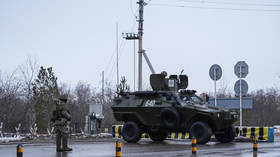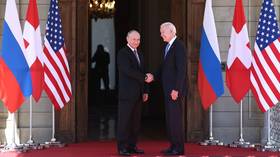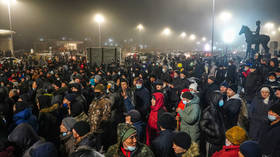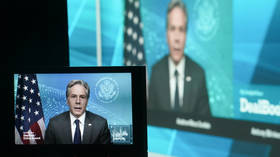Kazakhstan shows US influence is on the wane

The bloody civil conflict in Kazakhstan, and the speed with which it has spiraled, has taken the world by surprise – so much so that politicians and analysts seem to have struggled to come up with narratives to describe events.
Western governments, journalists and pundits have, as a result, had to fall back on a series of platitudes and clichés about the battle between democracy and authoritarianism, while focusing on the threat of Russia’s involvement and its purported intention to restore the Soviet Union.
For its part, Moscow has backed the Kazakh government’s version of events, with President Vladimir Putin declaring the unrest to be “aggression” leveled against the Central Asian nation and, along with other members of the CSTO mutual defense pact, has deployed troops to the region as part of a peacekeeping mission.
As much of the international community works to catch up with the reality on the ground, few seem to have begun asking what the consequences of the crisis will be.
The causes
The mass protests across the country were sparked by the removal of vehicle fuel price caps, which saw the cost of filling cars with LPG skyrocket. The wider disgruntlement, however, has clearly been fomented by an economy that stagnated over the past years, higher inflation, growing private debt, and unemployment.
Social and economic tensions also helped unravel the political transition in Kazakhstan. Nursultan Nazarbayev was president of Kazakhstan for almost 30 years until he stepped down in 2019 and was replaced by Kassym-Jomart Tokayev. In reality, a transition period had been underway in which Tokayev and Nazarbayev led Kazakhstan in tandem. Competing policies and loyalties were brought to the surface in a power struggle between the former and current president.
There were certainly many legitimate reasons for protesting against the government. However, a radical minority appears to have seized momentum and hijacked the peaceful protests. The radicals quickly gained access to automatic weapons that were turned against the police and military. Government buildings were attacked and seized in what appears to have been an attempted coup.
It has been suggested that foreign involvement added another layer of complication to this conflict. Tokayev accused the radicals of being funded and trained from abroad, although he did not name the US specifically. China has more openly blamed Washington for inciting another colour revolution, while Putin has compared the events to the Western-backed Maidan coup in Ukraine in 2014.
The evidence for American involvement has not been presented, and such serious allegations would have to be substantiated with hard proof. However, the suspicion that the US could have played a role clearly stems from the fact that its perennial tools of regime change, such as the National Endowment for Democracy, are involved in Kazakhstan and typically fund anti-government movements. The country, it must be noted, is an indispensable part of both the Russian-led Eurasian Economic Union and China’s Belt and Road Initiative, making it a strategic hub in the region.
The consequences
With the crisis quickly spiraling out of control, President Tokayev requested support from the Russian-led CSTO military bloc, of which Kazakhstan is a member. Moscow agreed to the request and the crisis subsequently began stabilising immediately. The psychological effect was immediate as any internal split and uncertainties within the security agencies, military and police started to fade. Moscow and Beijing have both given their full support to Tokayev, the legitimate president of Kazakhstan. However, while the crisis appears to be coming to an end, the economic and nationalist problems remain.
One of the big winners from this development is obviously President Tokayev. The long transition of power has now come to an end as Tokayev survived the uprising against his government and is now dismantling the tandem by asserting control over the government and getting rid of Nazarbayev’s people.
Russia also appears to come out of this crisis strengthened. Stability in Kazakhstan is imperative for Moscow, and the multilateral CSTO has asserted itself as a credible security provider in the region. The credibility of the bloc suffered to some extent from its passive role in the conflict between Armenia and Azerbaijan, although this success has restored the relevance of the military alliance.
The Russia-China strategic partnership has also been strengthened from this event. Instead of causing divisions that opened up the region to external influence, Moscow and Beijing aligned their positions in the spirit of the Greater Eurasian partnership and appear to come out stronger from the event. Furthermore, Beijing looks to Moscow as an indispensable partner to restore order in central Asia – which ensures greater equality in the partnership between the two Eurasian giants.
However, it can be expected that Russia and the CSTO will pull out as soon as possible since a prolonged presence could be counter-productive, and the government has said they will begin the withdrawal within the next few days.
Kazakh nationalists appear to have been a significant part of the radicals, and as approximately a quarter of Kazakhstan’s population consists of ethnic Russians, a prolonged presence of the Russian military could contribute to rather than soothe ethnic tensions. Some in the Western media appear to be stoking ethnic tensions by speculating about a possible Russian annexation of Kazakh territory, while US Secretary of State Antony Blinken similarly attempts to fuel tensions by suggesting the Russian military will not leave: “I think one lesson in recent history is that once Russians are in your house, it’s sometimes very difficult to get them to leave.”
Continuing uncertainty
It is very possible that Kazakhstan’s multi-vector foreign policy will shift more in favour of Russia and China, while the US, EU and Turkey will probably lose influence.
The US is obviously not happy with how the conflict ended. Washington is grasping desperately for a strategic narrative by proclaiming to speak on behalf of “peaceful protesters,” questioning whether the invitation if the CSTO was legitimate, and accusing Russia of attempting “to re-exert a sphere of influence over countries that previously were part of the Soviet Union.”
American politicians had not expected the involvement of the CSTO, and Blinken has asked for clarifications over why Kazakhstan “felt compelled to call in this organization that Russia dominates.” It is no secret that both the US and the EU avoid diplomatic ties and cooperation with the CSTO and other institutions that include Russia, in the effort to deprive these institutions of legitimacy. However, the unipolar era is long gone and the ability of the West to monopolise on security has come to an end. The Kazakh precedent will likely have wider implications for the post-Soviet space as the CSTO reasserts itself.
The statements, views and opinions expressed in this column are solely those of the author and do not necessarily represent those of RT.
The statements, views and opinions expressed in this column are solely those of the author and do not necessarily represent those of RT.















